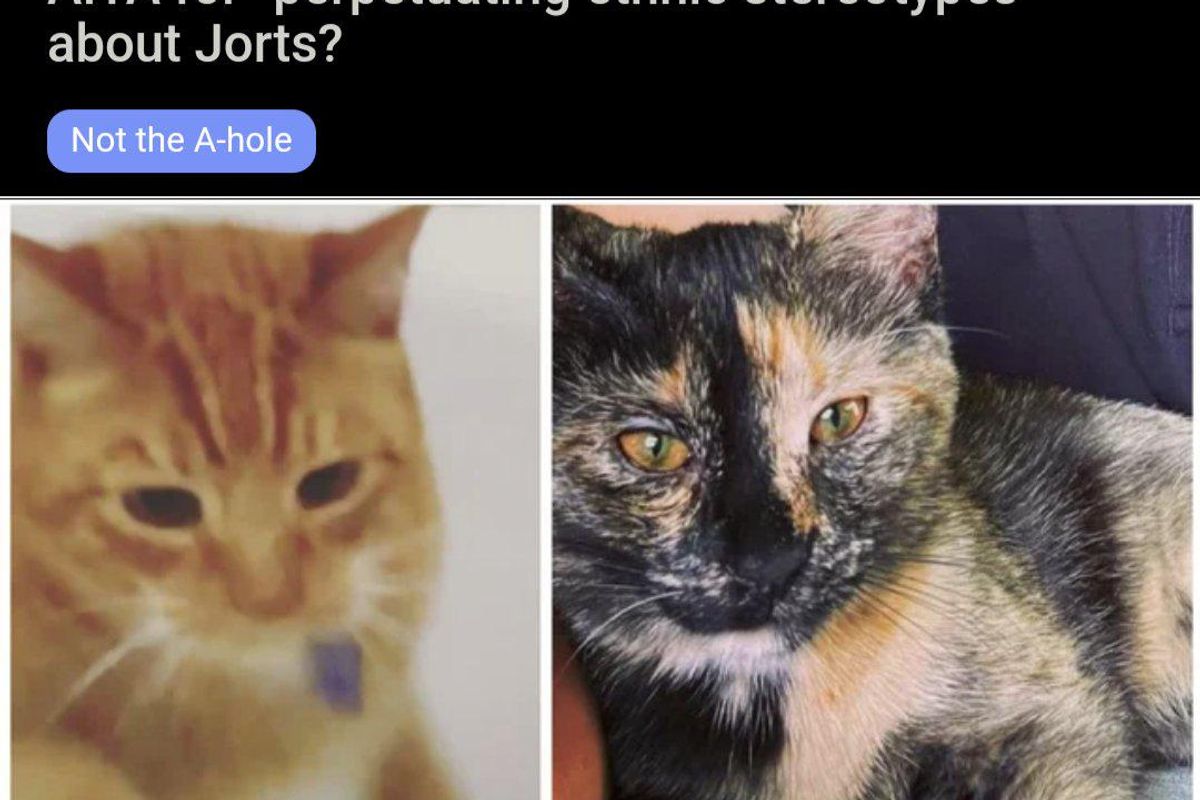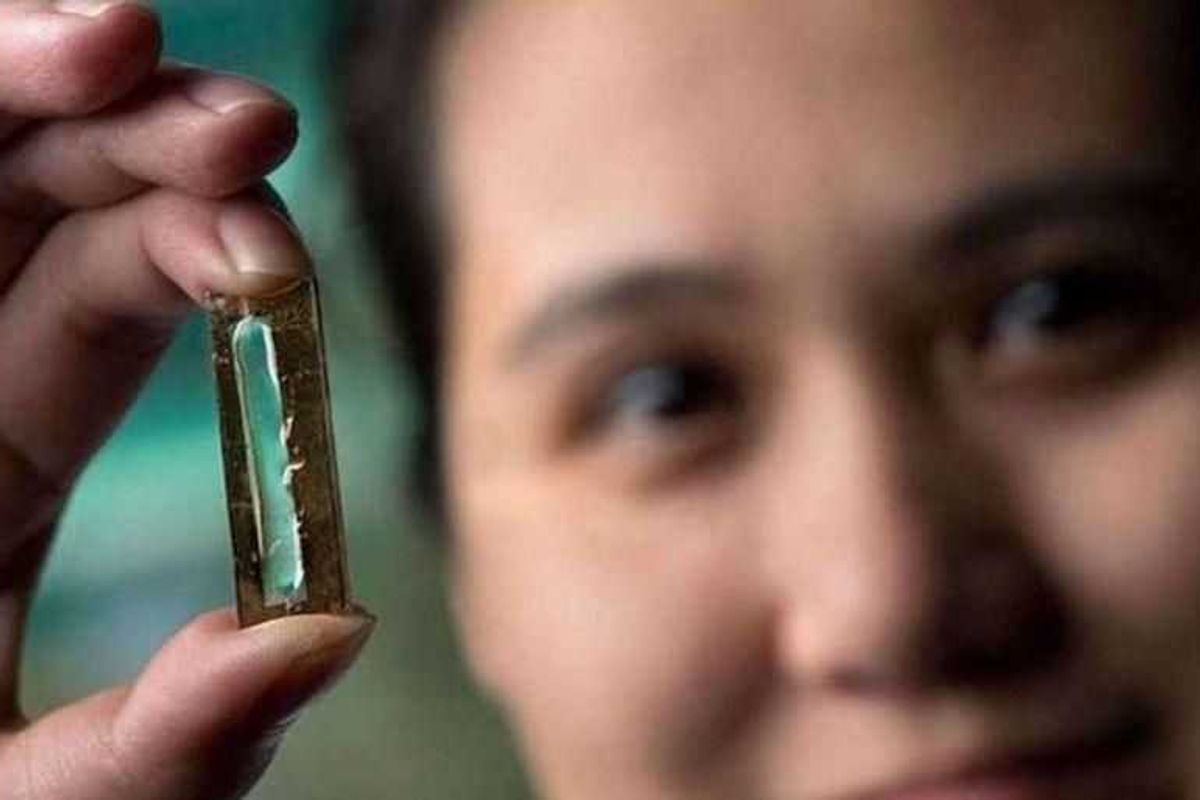Epic coworker spat over two workplace cats, Jean and Jorts, just keeps getting funnier

Jorts the dumb orange cat, Jean the smart Torty, and their overly concerned coworker Pam have people rolling.
If you thought cats were quirky, wait until you hear about the humans who have cats in their workplace.
In the popular AITA subreddit, in which people share personal stories and ask other users "Am I the Asshole?" it's common to find bizarre scenarios in which people behave in head-scratching ways. But a recent AITA inquiry takes the prize for the most hilarious, strange and thoroughly entertaining saga of workplace weirdness ever shared.
The initial story shared by Reddit user u/throwawayorangecat is funny enough, but the follow-up is even better.
AITA for \u201cperpetuating ethnic stereotypes\u201d about Jorts? https://bit.ly/3ytjsLC\u00a0pic.twitter.com/pHFeuxhoqH— Am I the Asshole? (@Am I the Asshole?) 1639516021
Redditor u/throwawayorange cat, who works at in an undisclosed profession that involves providing "service to clients in very sad/stressful points in their lives" wrote:
"We have two workplace cats in one area of our worksites. They add value to the worksite, we all love the cats and the worksite cat presence is not the issue. One of the cats (Jean) is a tortoiseshell cat we have had for years. The other cat (Jorts) is a large orange cat and a recent addition.
Jorts is just… kind of a simple guy. For example, Jorts can’t open a door even when it’s ajar— he shoves it whether he is going in or out, so often he closes the door he is trying to go through. This means he is often trapped inside the place he was trying to exit and meows until he is rescued.
My colleague Pam (not her real name) has been spending a lot of time trying to teach Jorts things. The doors thing is the main example — it’s a real issue because the cats are fed in a closet and Jorts keeps pushing the door closed. Jean can actually open all the other interior doors since they are a lever type knob, but she can’t open this particular door if she is trapped INSIDE the closet.
Tortie Jean is very nice to poor orange Jorts, and she is kept busy letting him out of rooms he has trapped himself in, so this seems easy to resolve. I put down a door stop.
Pam then said I was depriving Jorts of the 'chance to learn' and kept removing the doorstop. She set up a series of special learning activities for Jorts, and tried to put these tasks on the whiteboard of daily team tasks (I erased them). She thinks we need to teach him how to clean himself better and how to get out of minor barriers like when he gets a cup stuck on his head, etc. I love Jorts but he’s just dumb af and we can’t change that.
Don’t get me wrong— watching her try to teach Jorts how to walk through a door is hilarious, but Jean got locked in the closet twice last week. Yesterday I installed a cat cutout thing in the door and Pam started getting really huffy. I made a gentle joke about 'you can’t expect Jean’s tortoiseshell smarts from orange cat Jorts' which made Pam FURIOUS. She started crying and left the hallway, then sent an email to the group (including volunteers) and went home early.
In her email Pam said I was 'perpetuating ethnic stereotypes by saying orange cats are dumb' and is demanding a racial sensitivity training before she will return. I don’t think it’s relevant but just in case, Pam is a white person in a mostly minority staff (and no she is not ginger/does not have red hair).
TL;DR: AITA for ‘enforcing an ethnic stereotype’ by joking that orange cats are often dumb?"
The responses to the original post were decidedly in the "No, you're not the a-hole" camp, with comments ranging from "Um, you can't be racist against an animal," to "Why is Pam spending so much of her work time trying to train a cat?" Others chimed in with their own experiences with dumb orange male cats.
Then came the update—oh, the glorious update—that took the whole thing to a whole other buttery level.
"Thanks for responding to my query which had truly upset me. I work to have a good relationship with my team and the situation had gotten weird so gradually that I lost perspective.
I just met with HR, she had already met with Pam. HR was concerned about Pam’s comparing ethnic stereotypes with giving a cat a doorstop and they addressed that which went well. HR will follow up to make sure Pam understands. (The replies to my query were helpful to me for this discussion.)
HR also addressed Pam assigning other staff Jorts-related tutoring, as it is not appropriate for Pam to assign others work. This also went well.
We both think Pam had a hard time with the transition from volunteer to staff, and may have 'new kid' sensitivity projected to Jorts. Pam got emotional about her perception that I favor Jean over Jorts and gave specific examples. Some of these things are fair. Jorts deserves respect as a member of our team.
There are 3 buildings in our workplace. Jean and Jorts are limited to one. HR told me there were 5 holdouts about vaccines, and restricting unvaccinated people from entering the building (to protect Jean and Jorts) was enough to win over 4 of them. That’s CRAZY, but great.
More importantly: the cats’ presence greatly enhances our work with our clients, and Jorts’ friendly nature has been so great. Both cats truly are doing important work. Truly Jorts deserves to be treated with respect.
We all deserve to be treated with dignity at work, so I will apologize to Jorts about some things that were insensitive or disrespectful.
a. Jean has a nice cat bed with her name on it, while Jorts has chosen an old boot tray in my office with a towel in it. Recently a visitor put wet boots in the boot tray and Pam saw Jorts sleeping on the wet boots. I bought a bed for Jorts today and a name tag has been ordered.
b. I will apologize to Jorts and remove the sign saying 'DAYS SINCE JORTS HAD A TRASH CAN MISHAP: 0' Jorts likes to fish dirty paper cups out and he often falls into the bin or gets a cup stuck on his head, etc. (He is able to get out of the bin by tipping it over so it isn’t a safety issue.)
c. Jean’s 'staff bio' has a photo of Jean, while Jorts’ bio has a photo of a sweet potato. I did not actually know either cat had a staff bio, but we will use a photo of Jorts instead of a sweet potato.
HR also suggested changing Pam’s duties so she is 'in charge' of the cats. This I refused, the cats are my staff, not Pam’s. I think Pam was well-intended but actually not meeting the needs of either Jean or Jorts so they remain under my supervision. (Pam is also not to put cups on Jorts’ head or intentionally put him into frustrating situations given his unique needs.)
Lastly, and this made us both laugh so hard we can’t deal with it in person and will be said via email: Pam admits that she has been putting margarine on Jorts in an attempt to teach him to groom himself better. This may explain the diarrhea problem Jean developed (which required a vet visit).
Pam is NOT to apply margarine to any of her coworkers. Jean has shown she is willing to be in charge of helping Jorts stay clean. If this task becomes onerous for Jean, we can have a groomer help. I am crying laughing typing this.
added: I’m so glad this brought joy. Fan mail can be directed to jortsandjean @ gmail dot com.
or follow the Jorts and Jean joke account on twitter @JortsTheCat"
She buttered the cat. Oh, Pam.
The tale of Jean and Jorts launched a flurry of responses from the hilarious creatives of the internet, from memes to poetry.
I think we all agree @time made a huge mistake today. I demand some recognition for Jorts.pic.twitter.com/XCX0RJbcZo— no dead weight (@no dead weight) 1639531880
My name is Jorts\nAnd wen im fed\nOr wen a cup\nis on my hed\nI just need help\nto set me free -\nand thats the tyme\nPam butters me.— evilrooster (@evilrooster) 1639579915
We stand in solidarity with @JortsTheCat in my workplace!pic.twitter.com/nTdFkPjJlC— lia \ud83d\udc08\u200d\u2b1b (@lia \ud83d\udc08\u200d\u2b1b) 1639681000
People even started getting literary with the Jorts jokes, from a parody of a William Carlos Williams poem:
This is just to say\n\nI have buttered \nthe Jorts\nwho was in \nthe closet\n\nand who \nyou were probably \nkeeping around \nfor staff morale\n\nforgive me\nhe was adorable \nso stupid\nand so orange— Lou (@Lou) 1639569344
To a "Pride and Prejudice" comparison:
here\u2019s Jean and Jortspic.twitter.com/EzthwbezaT— Helena Fitzgerald (@Helena Fitzgerald) 1639580564
To a well-known "Lord of the Rings" quote:
I feel thin, stretched, like butter scraped over too much Jorts— Founding member of Jorts fan club (@Founding member of Jorts fan club) 1639585655
Who knew that workplace cats could provide such ongoing entertainment for countless pandemic-weary humans? Thank you, "Pam" for being such a quirky coworker and giving us all a reason to cheer for Jorts, the dumb orange cat.
- Changing the false stigmas about black cats requires patience ... ›
- A Canadian shelter sells older cats like used cars, and it's pretty ... ›
- Couple's video of their cats having a 'spaw day' has taken the ... ›
- Ultimate thrift shop find: Kitty accidentally gets 'donated' while hiding in a recliner - Upworthy ›
- This TikTok couple has the clingiest cat you've ever seen - Upworthy ›
- Jinx the cat became the mayor of Hell - Upworthy ›
- Two cats had to be rehomed, and it's surprisingly sweet story - Upworthy ›
- Video of cats being badass gives us new respect for them - Upworthy ›
- The Kiffness' 'Alugalug Cat' duets are genuinely amazing - Upworthy ›
- The Kiffness' 'Alugalug Cat' duets are genuinely amazing - Upworthy ›
- Five hilarious gift books for cat lovers - Upworthy ›
- Choir boys sing a cat duet opera using only 'meow' - Upworthy ›
- New study shows keeping cats indoor is safer - Upworthy ›
- Owner writes moving goodbye letter to belated cat Marty - Upworthy ›
- A cat named Santos is an adorably supportive dad and partner - Upworthy ›
- TikTok user put camera on cat collar and it's amazing - Upworthy ›
- Wife upset husband didn't defend her during armed robbery - Upworthy ›
- Oscar, the extraordinary hospice cat who could predict death - Upworthy ›
- Woman shows her misbehaving cat to 'the trenches' - Upworthy ›
- Nora the piano cat plays CATcerto with a full orchestra - Upworthy ›
- Tabby hailed 'evil genius' for diabolical basket scheme - Upworthy ›
- Pet owner put GPS on cat and dog during a walk - Upworthy ›
- Cat of the Year winner spends his days comforting abused women - Upworthy ›
- Woman builds hotel for stray cats to stay warm in winter - Upworthy ›
- What you should know about having a cat before getting one - Upworthy ›
- Why do cats 'make biscuits'? 6 reasons cats knead. - Upworthy ›
- The real reasons cats make that 'ekekek' chattering noise - Upworthy ›
- 'If Cats Went to School' video nails quirky cat behavior - Upworthy ›
- Former Levi's CEO Charles Bergh settled the debate on how often you should wash your jeans - Upworthy ›
- How were cats domesticated? It didn't start with the Egyptians. - Upworthy ›
- Woman builds an elaborate hotel in her yard for stray cats to stay cozy through the winter - Upworthy ›
- Geneticists find the sex-linked gene that makes orange cats - Upworthy ›
- Veterinarian delivers best response after being told it's 'disgusting' to let cats on furniture - Upworthy ›
- Pet behaviorist explains the viral phenomenon of people buying their cats concrete slabs - Upworthy ›
- 19 cats have drowned in Amsterdam's canals in the past 6 months. The city is taking action. - Upworthy ›
- Obsessed cat dad builds an entirely feline-friendly miniature subway system with all the frills - Upworthy ›
- 6th grader's science fair project answers age-old question: 'Do cat buttholes touch everything?' - Upworthy ›
- Veterinarian shares 7 signs your cat loves you - Upworthy ›




 Women don't need unsolicited male advice, not on the golf course, not at the gym, not anywhere. Photo by
Women don't need unsolicited male advice, not on the golf course, not at the gym, not anywhere. Photo by 

 Phone charging.
Phone charging. bill nye chemistry GIF by NETFLIX
bill nye chemistry GIF by NETFLIX 
 TikTok · Ale
TikTok · Ale
 It's sweet when they make you a "cheer up" card, but it shouldn't be happening all the time. Photo by
It's sweet when they make you a "cheer up" card, but it shouldn't be happening all the time. Photo by